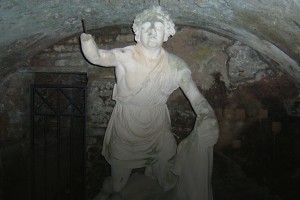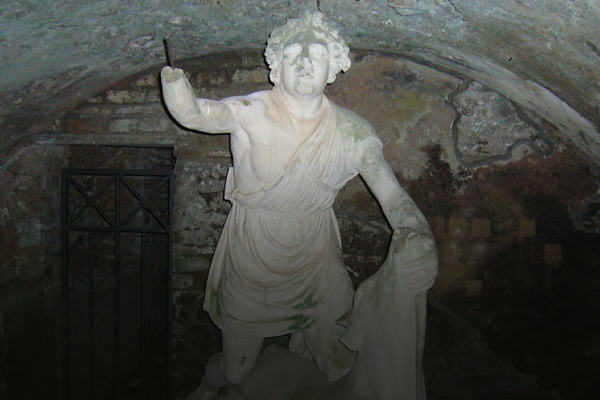
There are two distinct (and non-continuous) traditions related to Mithras, one coming out of the areas of India and Iran, centuries prior to the birth of Jesus, and another developed in Roman times concurrent with the Christian era. Many experts have struggled to try to connect these as one continuous tradition, and in so doing, have distorted or misinterpreted the basic elements of the tradition and mythology. There is no surviving Mithraic scripture; most of what is known about Mithras comes from statues and murals that have no captions, or from the writings of ancient Christians who described Mithraic rituals many years after the arrival of Jesus. The vast majority of scholarly work on this mythological character is pure speculation. Given that foundation, let’s take a look at some of the alleged similarities between Mithras and Jesus:
Claim: Mithras was born of a virgin on December 25th, in a cave, attended by shepherds
Truth: Mithras was actually born out of solid rock, leaving a cave. He was not born of a virgin (unless you consider the rock mountain to have been a virgin). His birth was celebrated on December 25th, but both Mithras worshippers and the earliest Christians borrowed this celebration from earlier winter solstice celebrations. The earliest version of the Mithras narrative that includes shepherds appears one hundred years after the appearance of the New Testament; it is far more likely Mithraism borrowed the shepherds from Christianity than the other way around.
Claim: Mithras was considered a great traveling teacher and master
Truth: There is nothing in the Mithras tradition that indicates he was a teacher of any kind, but he could have been considered a master of sorts. But why would we expect any deity to be anything less than a great teacher and master?
Claim: Mithras had 12 companions or disciples
Truth: There is no evidence for any of this in the traditions of Iran or Rome. It is possible that the idea that Mithras had 12 disciples came from a mural in which Mithras is surrounded by twelve signs and personages of the Zodiac (two of whom are the moon and the sun), but even this imagery is post-Christian.
Claim: Mithras promised his followers immortality
Truth: While there is little evidence for this, it is certainly reasonable to think that Mithras did offer immortality, although this is not uncommon for any god of mythology.
Claim: Mithras performed miracles
Truth: This claim is true, but what mythological god didn’t perform miracles?
Claim: Mithras sacrificed himself for world peace
Truth: There is little or no evidence that any of this is true. The closest Mithraic narrative is a story in which Mithras killed a threatening bull in a heroic deed.
Claim: Mithras was buried in a tomb and after three days rose again, and Mithras was celebrated each year at the time of His resurrection (later to become Easter)
Truth: There is nothing in the Mithras tradition that indicates he ever even died, let alone was buried or resurrected. Tertullian, the ancient Christian Case Maker, did write about Mithraic believers re-enacting resurrection scenes, but he wrote about this occurring well after New Testament times. This again appears to be another example of Mithras followers borrowing from Christianity (in the Roman version of the Mithraic religion).
Claim: Mithras was called “the Good Shepherd”, and was identified with both the Lamb and the Lion
Truth: There is no evidence that Mithras was ever called “the Good Shepherd” or identified with a lamb, but Since Mithras was a sun-god, there was an association with Leo (the House of the Sun in Babylonian astrology), so one might say that he was associated with a Lion. But once again, all of this evidence is post New Testament, and cannot, therefore, have been borrowed by Christianity.
Claim: Mithras was considered to be the “Way, the Truth and the Light,” and the “Logos,” “Redeemer,” “Savior” and “Messiah.”
Truth: Based on the researched, historic record of the Mithraic tradition, none of these terms have ever been applied to Mithras deity with the exception of “mediator”. But this term was used in a way that was very different from the way that it is used in the Christian tradition. Mithras was not the mediator between God and man but the mediator between the good and evil gods of Zoroaster.
Claim: Mithras celebrated Sunday as His sacred day (also known as the “Lord’s Day,”)
Truth: This tradition of celebrating Sunday is only true of the later Roman Mithras followers; it is a tradition that dates to post-Christian times. Once again, it is more likely to have been borrowed from Christianity than the other way around.
It is reasonable that ancient people groups, thinking about the world around them and the existence of God, would assign certain characteristics to God, and it’s also reasonable that many of these groups might begin to imagine God with some measure of accuracy. But when you take the time to investigate the initial claims of those who say Jesus is similar to some ancient mythological god, you’ll quickly discover that those pre-Christian deities aren’t much like Jesus after all.
For more information related to Mithras:
The Origins of the Mithraic Mysteries (Cosmology and Salvation in the Ancient World) by David Ulansey (Oxford University Press, 1989), Mithras, the Secret God by M. J. Vermaseren (Barnes and Noble Publishers, 1963), and Mithraic Studies (Proceedings of the First International Congress of Mithraic Studies – 2 Volumes) edited by John R Hinnells (Manchester University Press, 1975).

J. Warner Wallace is a Dateline featured Cold-Case Detective, Senior Fellow at the Colson Center for Christian Worldview, Adj. Professor of Christian Apologetics at Talbot School of Theology, Biola University, author of Cold-Case Christianity, God’s Crime Scene, and Forensic Faith, and creator of the Case Makers Academy for kids.
Subscribe to J. Warner’s Daily Email
Save
Save
J. Warner Wallace is a Dateline featured cold-case homicide detective, popular national speaker and best-selling author. He continues to consult on cold-case investigations while serving as a Senior Fellow at the Colson Center for Christian Worldview. He is also an Adj. Professor of Christian Apologetics at Talbot School of Theology, Biola University, and a faculty member at Summit Ministries. He holds a BA in Design (from CSULB), an MA in Architecture (from UCLA), and an MA in Theological Studies (from Gateway Seminary).

































Pingback: SiftingPoint | Atheists Are Wrong: Those Pre-Christian Deities Aren’t Much Like Jesus After All
Pingback: J. Warner Wallace – Those Pre-Christian Deities Aren’t Much Like Jesus After All » Christian Apologetics & Intelligence Ministry
Pingback: The Reasonable Expectations That Cause Mythologies to Resemble Jesus | Cold Case Christianity
Pingback: Is Jesus Simply a Retelling of the Horus Mythology? | Cold Case Christianity
Pingback: Those Pre-Christian Deities Aren’t Much Like Jesus After All | TLG Christian News
Pingback: The Virgin Birth in Context | Curly's Corner
Ande
November 7, 2022 at 1:48 pm
We live in the latter days in which many lies will arise and the truth shall be hated. Unfortunately, despite all the evidence against their theories, ‘Zeitgeisters’ and ‘Hoteps’ will believe what they want because they hate the Truth.